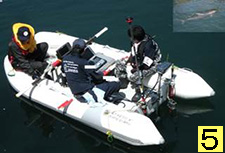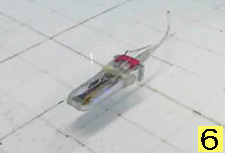Aquatic Sciences: Aquatic Biology and Marine Environmental Sciences
From microscopic plankton to giant whales, over 90 percent of organisms live within the aquatic ecosystems, but we know very little about most of these species and the ecosystems they inhabit. The Division of Aquatic Science seeks to understand patterns of biodiversity and quantify change in the aquatic ecosystem by studying how organisms interact with their environment and respond to change. We have two courses with an emphasis on the physical and biological approaches
1. Aquatic Biology
This is a marine and freshwater science course with an emphasis on the biological aspects of the aquatic plants and animals including their ecosystem. You can learn at the sophisticated facilities in Kagoshima University as well as in the spectacular nature including the World Natural Heritage. You will get first-hand experience in various research methods for Aquatic Biology, like gathering live samples and collecting and assessing data. Furthermore, you will study the whole range of aquatic organisms, and their interactions with each other and their environment.
Students receive instruction and training in a broad range of techniques and subjects, including biodiversity, ecology, ecophysiology, systematics and the environmental studies. Our interest covers the full diversity of marine and freshwater life, from microscopic algae to marine fish and mammals. The experienced professors present dynamic classroom lectures that will expose you to the amazing world of the Aquatic Biology. We produce marine biologists with knowledge and skills who can be successful on a global scale.
2. Marine Environmental Sciences
The course of Marine Environmental Sciences provides an educational curriculum to learn studies on the marine environment from scientific and engineering aspects; the scientific aspect contributes knowledge of the physical system governing the ocean, and the engineering aspect provides methods to conserve and develop marine environments. For this purpose, students are encouraged to learn basic knowledge for mathematics, physics and information sciences.
Field teaching
Field teaching is at the center of learning in this course, because it gives students an understanding of the natural environment that cannot be achieved in the classroom alone. Our residential field course locations currently include Kagoshima proper and the northern Ryukyu Islands.
Excellent facilities
Kagoshima University has invested heavily in teaching facilities. Our building (#5 Bld) was recently given a complete refurbishment, and our university training vessel Kagoshima-Maru was renewed in 2013. You can learn at one of the newest fisheries biological facilities in Japanese universities.
Career prospects
Our graduates have gone on to a diverse range of careers, including the fisheries scientist, environmental consultancy, government officer, aquarium staff, teacher in the middle and high schools, and office worker in the various field of business market.
Many choose to continue their studies at Masters or PhD level at the graduate schools of Kagoshima University.
 |
 |
 |
 |
 |
 |
1. Field survey of the life history of Plecoglossus altivelis ryukyuensis in Amami Island by using the beach seine.
2. Field survey of the distribution of freshwater crab and shrimps in the remote island.
3. Preparation of the sterile seawater for the unialgal culture.
4. Field survey for the construction of the channel for dolphin breeding.
5. Multilateral researches of the Kuroshio Current by onboard and satellite measurements. Elucidating
the mechanism of the flow and the effect for the climate and biological organisms.
6. The development of autonomous fish-like robots |
Teaching Staff
| Professors |
Hirohiko NAKAMURA [Physical Oceanography, Dynamics of the Kuroshio Current] Lab Web Site |
| Hiroshi SUZUKI [Ecology and taxonomy of Crustacean Decapods] Lab Web Site |
| Ritsuo SHIGEHIRO [Maneuvering and Seakeeping of ships, Auto Control Technology] |
| Ryuichiro NISHI [Coastal Oceanography, Coastal Engineering] Lab Web Site |
| Tomoko YAMAMOTO [Community Ecology of Benthic Organisms] |
| Assoc. Prof. |
| Gen KUME [Ichthyology, Life History of Estuarine and Marine Fish)] |
Toru KOBARI [Biological Oceanography, Ecology and Biology of Phyto-and Zoo-Plankton]
/ Google Scholar Citation / Lab Web Site |
| Asst. Prof. |
Ayako NISHINA [Physical Oceanography] Lab Web Site |
Hikaru ENDO [Phycology, Biodiversity of Coastal Ecosystem] |
| Hirofumi SUMOTO [Underwater vehicles)] Lab Web Site |
| The United Graduate School of Agricultural Sciences (Doctor course) Professor |
Ryuta TERADA* [Phycology, Biodiversity of Coastal Ecosystem]* United Graduate School of Agricultural Sciences / Google Scholar Citation / Lab Web Site / Facebook |
|

